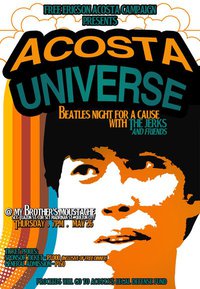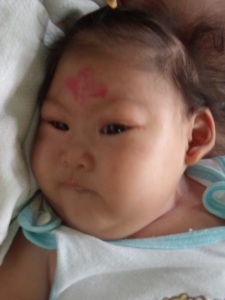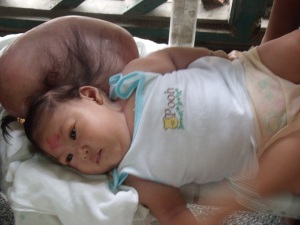 I did not particularly like Ericson back during our days in the Philippine Collegian. He always struck me then as some kind of mad man. Sometimes when he spoke he adopted accents: American, British, Chinese. Like a bird on speed he sang at the top of his voice during unexpected moments. On some mornings during weekend presswork, he could be found sitting at the conference table, his head cradled in one hand while his other held a burning cigarette. More often or not he’d be hung over, and, inevitably hungry. He’d try to wheedle/jokingly threaten younger staff members including myself into shelling out money (as a “loan”) to so he could go downstairs to the University Food Service cafeteria and buy a meal. Then afterwards he’d come back up to the office and he’d have a plate with him — one of the food service bone-white, heavy ceramic plates: he said he ‘merely “borrowed” it and will return it soon enough.
I did not particularly like Ericson back during our days in the Philippine Collegian. He always struck me then as some kind of mad man. Sometimes when he spoke he adopted accents: American, British, Chinese. Like a bird on speed he sang at the top of his voice during unexpected moments. On some mornings during weekend presswork, he could be found sitting at the conference table, his head cradled in one hand while his other held a burning cigarette. More often or not he’d be hung over, and, inevitably hungry. He’d try to wheedle/jokingly threaten younger staff members including myself into shelling out money (as a “loan”) to so he could go downstairs to the University Food Service cafeteria and buy a meal. Then afterwards he’d come back up to the office and he’d have a plate with him — one of the food service bone-white, heavy ceramic plates: he said he ‘merely “borrowed” it and will return it soon enough.
The plate already had at least a dozen siblings in the pantry, but to be fair some of them got there courtesy of some other felon.
 My liking for Ericson grew as soon as I saw that he was not really crazy and that he really did mean it when he smiled and said hello (a mutual friend once told me that Ericson was so mercurial, so seemingly unstable that when he smiled one couldn’t immediately be certain if he was sincere or if he was preparing to pull a prank on you). He was a good writer, I immediately saw. He wrote reviews and critiques and poems and he was obviously artistic (he strengthened views that artists really did straddle the divide between lunacy and genius). And music, he was also so deeply into it because he would sing even in the middle of meetings, and he sang at daybreak and he sang at midnight and he sang in the bathroom and we could all hear his voice through the wall and some of us would roll their eyes, “Ericson!”
My liking for Ericson grew as soon as I saw that he was not really crazy and that he really did mean it when he smiled and said hello (a mutual friend once told me that Ericson was so mercurial, so seemingly unstable that when he smiled one couldn’t immediately be certain if he was sincere or if he was preparing to pull a prank on you). He was a good writer, I immediately saw. He wrote reviews and critiques and poems and he was obviously artistic (he strengthened views that artists really did straddle the divide between lunacy and genius). And music, he was also so deeply into it because he would sing even in the middle of meetings, and he sang at daybreak and he sang at midnight and he sang in the bathroom and we could all hear his voice through the wall and some of us would roll their eyes, “Ericson!”
I could write hundreds of lines devoted to Ericson’s antics. About how he once took one of Amy’s sleeveless blouses and wore it with a pair of skimpy maong shorts which I don’t know where the hell he found. Then he went traipsing around the Collegian office like some kind of demented geisha with a plastic umbrella held afloat, an angry Amy at his heels demanding that he take off the blouse or die.
Then there’s the horror of sleeping on the mat next to the one that Ericson would eventually collapse on after an evening of downing beers at Sarah’s or Gulod: the unfortunate staffer would wake up and find himself or herself lying alarmingly close to a small pool of vomit, and it’s owner indifferent and dead to the world.
But I’ll reserve stories like those for when I’m with other friends who are equally awed and incensed by and fond of Ericson.
I never got to ask, but I don’t know how the heck he managed to get his hands on my essay about joining the League of Filipino Students (LFS) and the strangeness of discovering my country for the first time as it really was. I wrote the essay for my creative writing class under Prof. Cristina Pantoja-Hidalgo; it was mostly a personal piece because it was class on autobiographical writing. I must have left a copy on one of the computers and Ericson saw and read it. I didn’t know that it was going to be included in F1, the Literary Folio (also known as the FliterFlary to some of us) he edited until it came out and I held a copy in my hand.
Ericson, hindi ka nagpaalam na gagamitin mo yun. It was a personal essay, not meant for other eyes but Prof. Jing’s and having other people read it made me feel embarrassed, did you know? But I understand why you did it.
Hmm, now that I think about it, he also took a short story I wrote for Prof. Butch Dalisay’s Fiction II class and printed it in the Collegian, in the Kultura pages ( I was from the Features section or Feats). The story was about a unit of the New People’s Army (NPA) and how they were saved by a family of ghosts: they were farmers killed by the Armed Forces of the Philippines (AFP) and they gave the NPA unit shelter in their ghost bahay kubo. Maybe he found it a bit funny, a somewhat political ghost story!
(Don’t tell me about dialectical materialism: it was a a NON REALISTIC FICTION class, and again, it wasn’t like I ended to have the thing published. I intended for it get at a 1 in Prof. Dalisay’s class, but he only gave me a 1.25 and a kindly letter saying that he didn’t know what national democrats would think about my story if they read it.)
But I’m rambling. I have other memories of Ericson where he showed me kindness, where he displayed sensitivity for my feelings. It had to do with my being the girlfriend of the person who placed second in the editorial exams for the Collegian but cried foul, said there was cheating (there wasn’t) and insisted that he was the rightful editor-in-chief (he wasn’t, he really wasn’t.) In any case, it was a terrible time and everyone else looked at me with accusing eyes but Ericson, well, he didn’t even tell me (like the others did) to break up with the guy and good riddance.
Ericson talked to me in a quiet voice, and he asked if I knew what I was doing, if I was sure, and if I was, I should at least consider what the implications were on the campaign for the truth on who really placed first in the ed exams. It’s a complicated story and I earned a lot of grief from it, but my point is, Ericson was not self-righteous, he didn’t lecture me, and he was for all intents and purposes, a friend.
Fastforward to his work as poet, a cultural worker, an activist. He organized and headed Alay Sining, lead the establishment of Stand UP, wrote, directed and performed in a play about Andres Bonifacio he titled “Monumento.” His poems were transformed into songs and a decade later students still sing them as they played on guitars in picketlines, during student-led rallies, cultural activities. When he decided to go to the regions, he left many comforts behind but he was firm in his belief that he would be better off serving the poor in the provinces.
Through the years I only saw Ericson occasionally. His work kept him in the provinces, writing and doing research for farmers organizations and helping organize cultural groups among the peasants. Sometimes he came home and we’d see each other with a few other friends and he’d give me copies of publications he helped put together, show poems he’d written, artwork. He was thinner than I would’ve liked, but he always said that he was happy and that his work was the best kind in the world nevermind that it paid zero.
“Imagine doing the work you love everyday for the rest of your life. You don’t even miss money,” he said.
Before the first time left for the regions, I saw his and Kerima’s baby a few days after he was born. K looked a little worried about her new role, but Ericson exuded pride. We all sat there in their room full of books and paintings he made when he was younger and Ericson was a new father.
Now he’s a father away from his only child, his son. Away from his wife, away from his parents, away from friends and former colleagues who all have fond memories of him. Everyone worries for his safety, and hopes for his immediate release from detention.
Happy birthday, Ericson. Crossing my fingers and toes that your freedom comes soon and we can all hear you sing, do monologues, sing, recite poems, sing and be your happy, hopeful and amazing self again.
—————
http://www.freeacosta.blogspot.com
http://www.acostaprisondiary.blogspot.com
http://facebook.com/FreeEricsonAcosta.FreeAllPoliticalPrisoners



